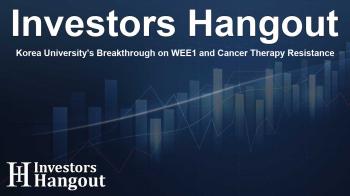Korea University's Breakthrough on WEE1 and Cancer Therapy Resistance

Groundbreaking Discovery on WEE1 and Cancer Resistance
Researchers at Korea University have made a significant breakthrough in understanding how some tumors resist immunotherapy. Their focus centers on the WEE1 protein, traditionally recognized for its role in regulating the cell cycle and acting as a tumor suppressor. However, the research reveals a duality—when situated in the cytoplasm of cancer cells, WEE1 takes on a role that promotes tumor survival and immune evasion.
A New Perspective on Immune Checkpoints
Immune checkpoints correspond to proteins that generally inhibit the immune system from attacking normal cells. Some cancer cells, however, hijack these checkpoints to shield themselves from immune surveillance. The immune checkpoint blockade (ICB) is an innovative treatment that employs antibodies to disrupt these misleading signals, enabling the immune system to combat cancer more effectively.
The Role of WEE1 in Immune Resistance
The key question emerging from this evolving segment of oncology is why certain tumors remain resilient against ICB therapies. The discovery made by Korea University researchers might hold the answer. The study identifies the cytoplasmic localization of the WEE1 protein as a significant factor in immune resistance within cancer cells.
Insights from the Research Study
According to Professor Tae Woo Kim from the Department of Biochemistry and Molecular Biology at Korea University, "Our findings reveal a non-traditional mechanism whereby WEE1 located in the cytoplasm facilitates immune resistance, indicating that targeting WEE1 could be a viable strategy for enhancing responses to ICB." This research has been documented in a recent issue of the Cancer Immunology Research journal.
The research involved analyzing RNA samples from patients battling metastatic melanoma and non-small cell lung cancer during ICB treatment. By comparing responders to non-responders, investigators noted elevated WEE1 expression among those who did not respond favorably, correlating it with adverse prognoses and aggressive tumor behavior.
Mechanisms Behind WEE1 Functionality
The study elucidates that the transcription factor NANOG upregulates WEE1 expression. In turn, when WEE1 is phosphorylated by AKT, it relocates to the cytoplasm, instigating a signaling cascade that further promotes cell survival through the HSP90A–TCL1A–AKT loop. This perpetuates heightened AKT activation, thus fostering an immune-resistant environment.
Implications for Future Treatments
Dr. Hyo-Jung Lee, a principal author of the study, expressed the significance of these findings: "WEE1 translocation to the cytosol is not just a simple movement; it initiates processes that enhance tumor cell properties, including immune evasion and stem cell-like characteristics." This characterization of WEE1 presents it as not merely a cellular regulator but also as a potential target for therapeutic intervention.
Notably, targeting WEE1 with existing inhibitors like adavosertib (AZD1775) has shown promise in potentially reversing tumor resistance by reactivating the immune system's ability to combat cancer effectively. This insight could lead to more comprehensive treatment strategies for tumors exhibiting resistance to immunotherapy.
The Road Ahead
The implications of this research extend beyond WEE1. It opens up discussions about the dual roles of other cell cycle regulators, suggesting a shift in how these proteins could be targeted in cancer treatments. By understanding the oncogenic implications of these proteins in various contexts, researchers may develop new combination therapies that enhance the efficacy of existing drugs.
Frequently Asked Questions
What is the significance of the WEE1 protein in cancer therapy?
The WEE1 protein is crucial in regulating cell cycles and, when located in the cytoplasm, promotes resistance to immunotherapy, making it a potential target for treatment development.
How do immune checkpoints affect cancer treatment?
Immune checkpoints can prevent the immune system from attacking tumors. Therapies targeting these checkpoints can unleash immune responses to eliminate cancer cells.
What findings did the Korea University study reveal about WEE1?
The study found that cytoplasmic WEE1 enhances tumor growth and immune evasion, suggesting its targeting can improve responses to immunotherapy.
What are the therapeutic implications of inhibiting WEE1?
Inhibiting WEE1 with agents like adavosertib may resensitize resistant tumors to immunotherapy, revitalizing the immune response against cancer.
How does this research change our understanding of cancer treatment?
This research shifts the perception of WEE1 from a tumor suppressor to a critical player in immune resistance, informing future therapies that target this molecule.
About The Author
Contact Hannah Lewis privately here. Or send an email with ATTN: Hannah Lewis as the subject to contact@investorshangout.com.
About Investors Hangout
Investors Hangout is a leading online stock forum for financial discussion and learning, offering a wide range of free tools and resources. It draws in traders of all levels, who exchange market knowledge, investigate trading tactics, and keep an eye on industry developments in real time. Featuring financial articles, stock message boards, quotes, charts, company profiles, and live news updates. Through cooperative learning and a wealth of informational resources, it helps users from novices creating their first portfolios to experts honing their techniques. Join Investors Hangout today: https://investorshangout.com/
The content of this article is based on factual, publicly available information and does not represent legal, financial, or investment advice. Investors Hangout does not offer financial advice, and the author is not a licensed financial advisor. Consult a qualified advisor before making any financial or investment decisions based on this article. This article should not be considered advice to purchase, sell, or hold any securities or other investments. If any of the material provided here is inaccurate, please contact us for corrections.

